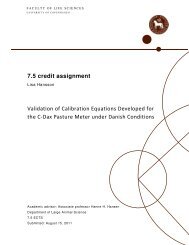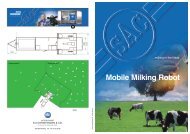Innovative Technology and Sustainable Development of Organic - 1.
Innovative Technology and Sustainable Development of Organic - 1.
Innovative Technology and Sustainable Development of Organic - 1.
You also want an ePaper? Increase the reach of your titles
YUMPU automatically turns print PDFs into web optimized ePapers that Google loves.
2.1 Introduction<br />
<strong>Organic</strong> dairy production has spread to a considerable production area in Europe (Anonymous,<br />
2006b). Policy-makers stimulated the growth <strong>of</strong> organic production starting mid eighties, by<br />
subsidizing conversion from conventional to organic production, <strong>and</strong> through extended research<br />
programs to provide practical knowledge (Mogensen, 2005). As a result, Denmark <strong>and</strong> the<br />
Netherl<strong>and</strong>s showed continuous growth <strong>and</strong> similar development <strong>of</strong> the organic production sector. The<br />
last few years, however, the number <strong>of</strong> organic dairy farms has not further increased (Table 1). Due to<br />
increasing herd size <strong>and</strong> milk production per cow, the total amount <strong>of</strong> organic milk has almost<br />
stabilized. In addition, the percentage <strong>of</strong> organic dairy farms relative to the total amount <strong>of</strong> dairy farms<br />
is rather constant during the years. In Denmark farm size <strong>and</strong> milk yield per cow have increased more<br />
than in the Netherl<strong>and</strong>s (Table 2), resulting in a decrease in the amount <strong>of</strong> organic dairy farms. This is<br />
parallel to general structural dairy development in the two countries, where in Denmark farm quota<br />
increased with 40% over the last four years <strong>and</strong> in the Netherl<strong>and</strong>s only with 20% (Anonymous,<br />
2006a).<br />
Table <strong>1.</strong> Total number <strong>of</strong> organic dairy farms in Denmark (DK) <strong>and</strong> the Netherl<strong>and</strong>s (NL) from 1990<br />
to 2005.<br />
1990 1995 1996 1997 1998 1999 2000 2001 2002 2003 2004 2005<br />
DK* 63 147 344 430 672 751 827 749 695 636 513 490<br />
NL** 71 80 95 m.v. 1 179 189 300 340 315 304 304 301<br />
* Figures from dairy industry in Denmark (www.mejeri.dk).<br />
** Figures from SKAL (certification body in the Netherl<strong>and</strong>s), LEI (www.lei.wur.nl ), <strong>and</strong><br />
EKO monitor (www.biologica.nl ).<br />
¹ m.v.; missing value<br />
Structural development like scaling-up <strong>of</strong>ten goes h<strong>and</strong> in h<strong>and</strong> with technological innovation, which<br />
is used to increase productivity or save labour. For example, the use <strong>of</strong> AMS in dairy production is<br />
increasing. The current percentage <strong>of</strong> dairy farms (organic <strong>and</strong> conventional) with an AMS is 4% in<br />
the Netherl<strong>and</strong>s <strong>and</strong> 8 % in Denmark (De Koning, 2006; Rasmussen, 2006). Application <strong>of</strong> such a new<br />
technology on an organic dairy farm, however, is not self-evident, just because it functions on a<br />
conventional farm (Alrøe <strong>and</strong> Kristensen, 2004). In Denmark, more than 9% <strong>of</strong> the 490 organic dairy<br />
farmers use AMS, <strong>and</strong> this percentage is increasing (Oudshoorn <strong>and</strong> de Boer, 2005). In the<br />
Netherl<strong>and</strong>s, however, AMS has been implemented only on <strong>1.</strong>7% <strong>of</strong> the 300 organic dairy farms<br />
(SKAL 1 , KOM 2 ). This is a divergent development in AMS use, in spite <strong>of</strong> uniform EU organic<br />
st<strong>and</strong>ards for both countries (see EEC regulation nr. 2092/91). The question arises if there are different<br />
perceptions between the Netherl<strong>and</strong>s <strong>and</strong> Denmark in how organic dairy production can contribute to<br />
future sustainable development <strong>of</strong> the organic dairy sector, as embedded by the international<br />
federation <strong>of</strong> organic agricultural movements. (Anonymous, 2005b).<br />
1 SKAL: Certification for <strong>Organic</strong> Production in the Netherl<strong>and</strong>s.<br />
2 KOM: “Kwaliteitszorg Onderhoud Melkinstallaties,” Quality Maintenance Milking Machines in the Netherl<strong>and</strong>s.<br />
Thesis Frank W. Oudshoorn 21




